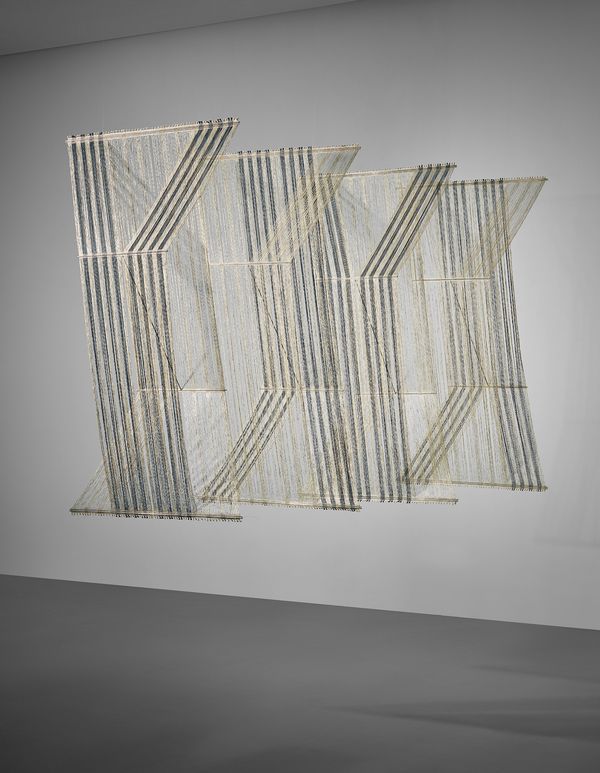Works by Rie, Coper and Collingwood are shown in harmony ahead of our Design sale on 20 September in London
Dame Lucie Rie studied under celebrated ceramicist Michael Powolny at the Kunstgewerbeschule in Vienna before immigrating to London in 1938.
Once settled in her new Albion Mews workshop, Rie, assisted by Hans Coper, started producing buttons for the fashion industry and, later, austere, sparsely decorated tableware that caught the attention of modernist interior decorators. Footed bowls and flared vases, for which she is best-known today, came after her attempts to conform her work to that of her contemporary British ceramists. Her much more advanced modernist style, however, eventually prevailed.
She worked with porcelain and stoneware, applying the glaze directly to the unfired body and firing only once. She limited decoration to incised lines (as seen in lots 1, 3), subtle spirals (lot 10) and golden manganese rims (lots 7, 22, 23), allowing the beauty of her thin-walled vessels to shine through and "the most interesting surface results to come from within the body"—as Emmanuel Cooper wrote for the Tate in 2009.
Upon emigrating from Germany in 1939, Hans Coper, a young Jewish engineer, began working in Rie's London studio. It was here that Coper learned his craft; initially assisting Rie with making ceramic buttons and tableware, Coper soon began producing his own work. By 1951 Coper had received considerable recognition for his pots at the "Festival of Britain." Favoring compound shapes, Coper created work of complex construction that seemed simple in appearance. He skillfully combined his thrown forms, joining multiple elements to create a singular entity. He eschewed glazes and preferred the textured surfaces achieved through the application of white and black slips, evoking the abraded texture of excavated vessels. Coper's interest in ancient objects placed him among other modernists of his time; Coper admired Constantin Brancuși and Alberto Giacometti while his textured markings have been compared to sculptors such as William Turnbull.
In the last phase of his career, tracing the decline in his physical health, Coper reduced the scale of his work, creating small 'Cycladic' pots, which stood on pedestals or drums, that recall the clay figures of Bronze Age Greece.
[After completing National Service], Collingwood started exploring the creative possibilities of the loom...
Peter Collingwood Set of four '3-Dimensional Macrogauze', circa 1980
Following in his father's footsteps, Peter Collingwood graduated from St Mary's Hospital Medical School in 1946. Despite the completion of his medical studies, Collingwood became interested in hand-weaving. His first encounter with the loom triggered an innate curiosity for mechanical machines, a fascination that he had since childhood. Upon his return to England after completing National Service, Collingwood was determined to abandon his medical career and he began employment at the workshop of hand-loom weaver Ethel Mairet.
It was here that Collingwood started exploring the creative possibilities of the loom, mastering the traditional techniques of weaving and understanding its limits. Constantly challenging the capabilities of his work, Collingwood focused his efforts on implementing its mechanical performance and spearheading progress by testing new structures of weaving. An example of Collingwood's innovative approach is the unique '3D Macrogauze' commissioned by Kiryu Performing Arts Centre in 1996, composed of nine panels produced with 'Alphatex' steel yarn (lot 8).
Collingwood stated in 1998, "…after acting as an artist to design the drawing, you become a technician to make it as perfect as possible." From the works of 'Anglefell' (lots 9, 19), 'Trianglefell', which won the Bavarian Gold Medal in 1963 and the two-dimensional (lots 5, 13, 20) and three-dimensional 'Macrogauze' designs (lots 2, 15), Collingwood always produced innovative weaving techniques and designs.
His first major retrospective was the seminal exhibition Collingwood | Coper at the Victoria & Albert Museum in 1969. The 'Macrogauzes' were shown in perfect harmony with the works of Hans Coper.



